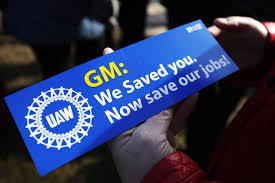
INDIANA – General Motors has reached a tentative deal with United Auto Workers to end their strike, according to two sources familiar with the talks.
GM joins Stellantis and Ford, which reached deals last week.
Neither the union nor GM would confirm the tentative deal. But this could bring an end to the union’s unprecedented strike against all three of the nation’s unionized automakers.

The tentative agreements, which must be ratified by union members at each of the respective carmakers, could end a strike against the Big 3 that began last month.
Terms of the deal are not yet known, but it is expected to be along the lines of the deals already announced at Ford and Stellantis, including an immediate 11% raise in the top hourly wage rate, additional pay hikes totaling another 14% during the four-and-a-half years of the contract, as well as a return of the cost-of-living adjustment (COLA) meant to protect workers from rising prices. When the COLA and guaranteed pay increases are combined together, they could lift members’ pay by more than 30% over the life of the contract.
Less senior workers not already at the top pay scale would get even larger pay increases, perhaps as much as 150%. Temporary workers would be made permanent full-time workers after a few months on the job. There would also be improved retirement benefits for senior workers who have traditional pension plans and larger company contributions to the 401(k) plans of workers hired since 2007.

The union announced its first deal, with Ford, this past Wednesday, and then announced a deal with Stellantis on Saturday night. The UAW then expanded the strike after there was no deal with GM to a fourth assembly plant, this one in Spring Hill Tennessee, as nearly 4,000 UAW members joined the strike.
Tentative agreements struck with Ford and Stellantis called for a roughly 25% raise over four years as well as significant improvements on pensions and the right to strike plant closures.
The union went on strike against all three automakers on September 15, nearly seven weeks ago, making this the longest US auto strike in 25 years. It started with a strike at one assembly plant at each company, but it expanded the scope of the strike six times since then in an effort to put pressure on the companies at the bargaining table.
The automakers had expressed reluctance to meet some demands from the union that they considered ambitious, saying such moves would take investment away from a costly shift to electric vehicles. The companies have also cited the need to compete with non-union competitors.

GM, Ford, and Stellantis faced pressure to reach a deal as financial losses piled up amid the strike. As of last week, the strike had cost the auto industry an estimated $9.3 billion, according to a report released on Monday by Michigan-based research firm Anderson Economic Group.
In a live-streamed address on Facebook on Sunday, UAW President Shawn Fain said the recent contract agreements would fuel the UAW’s wider ambitions to organize non-union carmakers, including Tesla, Honda, and Toyota.
“One of our biggest goals coming out of this historic contract victory is to organize like we’ve never organized before,” Fain said. “When we return to the bargaining table in 2028, it won’t just be with the Big 3. It will be the Big 5 or Big 6.”
The union, which represents nearly 150,000 autoworkers, launched a work stoppage against the Big 3 carmakers more than a month ago, deploying a “stand-up” strike method to target specific plants and add to the list if a deal wasn’t reached. At the peak of the strike, 46,000 employees refused to work.
The UAW sought ambitious demands such as a 40% pay increase combined over the four-year duration of a new contract, as well as a 32-hour workweek at 40-hour pay. Tentative agreements with Ford and Stellantis appeared to fall short of those terms but delivered significant raises and job security protections.



